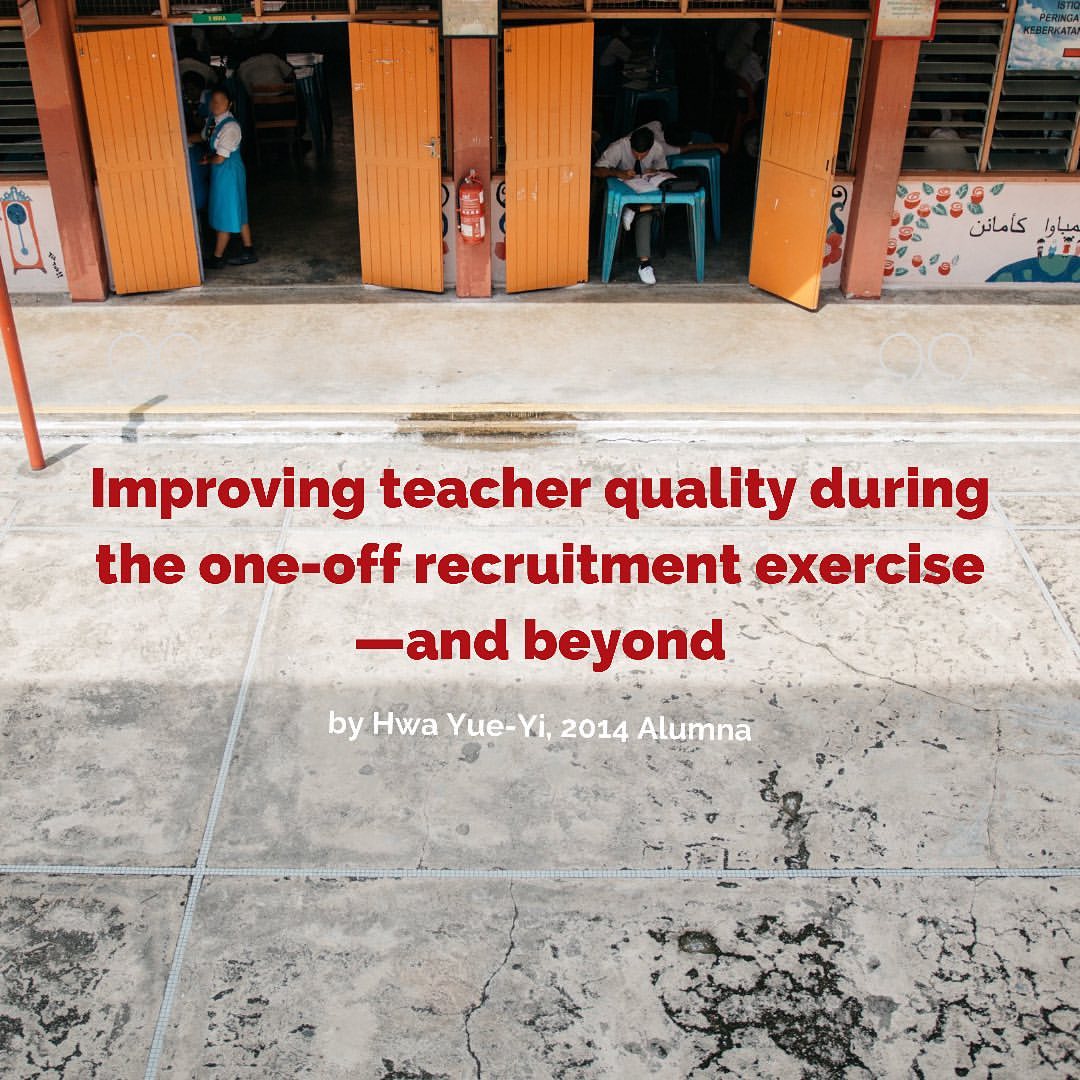Evidence from international research on education would fully support this emphasis on quality. It’s important to fill the teacher shortage to improve equitable access to education for children who are in schools today. But it’s even more important, in the long term, to fix deeper issues of quality throughout the whole teacher pipeline—and this one-off teacher recruitment exercise may be an opportunity to address some of these challenges.
This is especially true because our education system does not currently cultivate adequate learning levels for a large proportion of Malaysian children. In the 2018 round of the Programme for International Student Assessment (PISA), 46%—almost half—of 15-year-old students in Malaysia did not achieve expected minimum proficiency levels in reading. Performance in maths and science was only slightly better, with 41% and 37% of 15-year-olds, respectively, failing to meet the minimum benchmark.
Improving teacher quality through rigorous selection processes
A foundational element in improving teacher quality is improving the selection processes for entry into the teaching profession. It isn’t enough to choose teachers based on their formal qualifications or academic grades. Numerous studies have shown that there is little to no correlation between a teachers’ formal qualifications and their students’ learning—as in this review study which found that there was no link between whether a teacher had a master’s degree and how much their students learned.
Rigorous selection processes can demand a lot of resources, and this resource-intensiveness is an even greater challenge under COVID-19 limitations. For example, recent rounds of the Teacher Candidate Eligibility Test (Ujian Kelayakan Calon Guru, UKCG) have been conducted online with candidates answering the written test in their web browsers and uploading videos of themselves conducting sample teaching lessons.
But if we really believe that teaching is a distinct, specialised, mission-driven profession rather than a generic civil service administrative occupation, it is worth investing in rigorous processes for choosing teachers who embody the traits that we would want in those who educate our children.
Recent research studies have explored ways of assessing some crucial but complex aspects of teacher quality, such as pedagogical content knowledge (i.e. knowledge about how to develop learners’ understanding of specific subject areas) and non-cognitive/socioemotional skills. For example, researchers in Peru tested teachers’ pedagogical content knowledge by asking them to identify and explain common misconceptions that students have about mathematics. Similarly, researchers at the Teacher Selection Project in the U.K. have developed situational judgement tests to assess teacher candidates’ non-cognitive traits such as leadership, resilience, and motivation for teaching. Such assessments could greatly improve selection processes for teacher candidates.
From initial selection to long-term classroom effectiveness
However, it isn’t enough to just choose teachers based on the characteristics that they demonstrate before they enter the classroom.
This is because teacher characteristics that can be measured in standardised, external ways aren’t necessarily correlated with good teaching quality in-service. This has been demonstrated in numerous studies, such as a study in Pakistan which measured many teacher characteristics including how well they perform on tests in their subject areas, and a study in Ecuador which measured teachers’ performance on both a written test and a demonstration lesson.
To give a personal example, before I joined Teach For Malaysia on a two-year teaching Fellowship, many people told me that I would be a good teacher because I had always done well in school. But after I entered the classroom, I abruptly realised that there was much, much more to effective classroom teaching than knowing the subject matter well. One of my biggest struggles was managing classroom discipline. Even though my students liked me as a person, and even though I tried many different classroom management techniques, I consistently struggled to get all my students to listen to me at once. Those two years of school-based training and classroom practice gave me a lot of insight into the challenges of teaching and of education more generally—and confirmed for me that I would be more effective as an education researcher than a classroom teacher.
More generally, teachers’ capability and commitment during their first few years in the classroom should be an important part of the process to determine which teachers receive permanent appointments from the Education Service Commission (Suruhanjaya Perkhidmatan Pendidikan, SPP). In other words, novice teachers should undergo a meaningful, performance-based probationary period.
As stated in the 1966 ILO/UNESCO Recommendation Concerning the Status of Teachers, “A probationary period on entry to teaching should be recognized both by teachers and by employers as the opportunity for the encouragement and helpful initiation of the entrant and for the establishment and maintenance of proper professional standards as well as the teacher’s own development of his practical teaching proficiency. … the conditions for its satisfactory completion should be strictly related to professional competence.” Similarly, the World Bank recommends “… meritocratic selection of teachers, followed by a probationary period, to improve the quality of the teaching force”.
Crucially, the initial, novice years of teacher careers are important not only for identifying effective teachers, but also for inducting new teachers into the shared goals, values, and standards of the teaching profession. In the words of the ILO/UNESCO recommendation quoted above, a probationary period should serve as an opportunity for “the encouragement and helpful initiation of the entrant and for the establishment and maintenance of proper professional standards”.
Put differently, high-quality mentorship, induction, and socialisation of novice teachers can be an influential lever in careerlong teacher quality. Some research suggests that there are pre-existing shortcomings and challenges in the quality of novice teacher induction in Malaysia. These challenges will only be magnified during a large-scale, one-off recruitment of 3.7 times more new teachers than the number typically recruited each year.
In short, addressing the quantity and appropriate distribution of teachers is necessary for educational excellence—but it’s insufficient. We also need to address questions of quality, which include how selection processes set the stage for high-quality teaching, and how the initial years of classroom teaching are used to socialise, motivate, and identify effective teaching. These quality issues may be much harder to resolve. But they can be far-reaching in their outcomes.
“Building back better” to improve teacher quality in the long run
Amid the COVID-19 pandemic, there have been numerous calls to “build back better” rather than simply reverting to less-than-ideal practices and processes.
Similarly, this one-off recruitment exercise is an opportunity not only to fill current teacher shortages, but also to revitalise Malaysia’s teaching profession for the long haul.
For example, carefully designing selection and eligibility processes during this recruitment exercise could be an opportunity to refine and strengthen the UKCG and other parts of the teacher selection process more generally.
The particular challenges and opportunities experienced during the one-off recruitment exercise could be used to inform policy decisions about what combination of models would be most effective, in our Malaysian context, for giving novice teachers extensive engagement in real-life classroom practice before they receive permanent jobs—whether through a meaningful probationary period; a teacher residency model; the Teach For Malaysia/Teach For All model, which has been been shown to be effective in a range of countries; or the close partnerships between local schools and teacher training institutes practised in Finland that allow for much more intensive immersions in classroom teaching than the typical practicum model.
The coordination between the MOE, JPA, and SPP that has made this one-off recruitment exercise possible could be maintained and strengthened to ensure that similar challenges with the supply and distribution of teachers don’t happen in the future.
Imagine if one day we could look back on this shortage-driven, pandemic-constrained, one-off teacher recruitment exercise as a pivotal period in the MOE’s pursuit of its mission of “upholding a quality education system that develops individuals to their full potential and fulfils the aspirations of the nation”.





